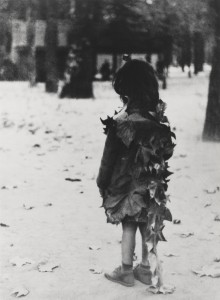
Édouard Boubat, Petite fille aux feuilles mortes, 1947
Gift of an Anonymous Donor
Digital photo: Travis Fullerton © Virginia Museum of Fine Arts
“Little Girl with Dead Leaves was indeed my first photograph.
These lights that shine in our childhood memories.
I was walking through the Jardin du Luxembourg after the war, in 1946. I had a Rollei camera that I’d bought by selling my big dictionaries. I was still twenty years old, I was a poet, I was in love. And of course, I wasn’t thinking about any of that at all. When your life is all ahead of you, all you want to do is live. And then years have passed by; the leaves fall every autumn. You don’t say no to beauty, you don’t say no to opportunity. When you’ve found something once, can you ever give it up again? The photo just happened.
Just one. A very pale negative developed in a makeshift lab. Am I still twenty years old today? Am I still in love? If I say yes, I still have a chance of finding that light.
I sometimes walk through the Jardin du Luxembourg, and I have never seen another little girl dressed in dead leaves. Every little girl is a little girl for the first time and everyone and everything I meet are just as I saw them for the first time. There is no such thing as a first photo. There are only new photos. The light is brand new today.
– Édouard Boubat, Paris, France, 1992
In a 2011 BBC interview, Grammy-nominated singer/songwriter Tori Amos reads the poem and gives her own impression of Little Girl with Dead Leaves.
Other works by Boubat, Robert Doisneau, and Joel Meyerowitz are on display at VMFA until October 28. Special thanks to Wendy May Martin for calling the poem and interview to our attention!